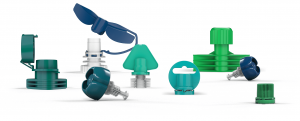4 Types of Molding Processes: Applications and Advantages:
Molding is one of the five core processes in rubber and plastic manufacturing, alongside casting, forming, machining, and additive manufacturing (AM). Molding involves a process of compressing and molding a thermoplastic material (e.g., plastic) to create a product (e.g., a bottle) or component (e.g., a ring) of that material. The process of molding involves the injection of the polymer into a mold (e.g., molding tool) to form the desired product shape.
There are four major types of molding processes: compression molding, injection molding, transfer molding, and melt molding. In compression molding, a pliable material (like plastic) is kept under pressure (e.g., air) until it solidifies or ‘vulcanizes’ into its final shape. This process is commonly used to create bottles, packaging trays, drinking cups, and other similar products.
Injection molding requires the use of thermoplastic materials with high durability and flexibility that can withstand high pressures and temperatures during the process of formation (i.e., vulcanization) of their final product shape. Melt molding is commonly used for forming bottle components made up of polyvinyl chloride (PVC) or polyethylene (PE). The polymers are heated above their melting point so they can assume a liquid form and become part of the final product
The advantage of using any type of molding process is that it can be customized to create various shapes and designs without requiring additional manufacturing steps or equipment besides the initial process itself.
Click Here to Read Part 1st
Our Manufacturing Process:
Injection molding is a process used to form plastic resin into desired shapes. The process begins with the material being heated and melted in the injection molding machine (or injection molding machine). A plunger or screw cylinder is used to inject the molten plastic into the prepared mold.
The injection molding machine uses pressure at a specific equilibrium (called gate) to hold the shape of the part until it freezes, known as ‘freeze’ or ‘setting’. Gate pressure is adjusted based on the material’s shrinkage, and due to backflow during the packing process. The parts are held at this pressure until they are removed from the molding machine. However, an injection molding machine usually has more than one cavity, which controls the temperature of each cavity and aids the uniformity of the manufacturing process.
Injection manufacturing is a cost-efficient method of manufacturing parts in high volumes. It’s also flexible and can be customized for various products and packaging requirements, resulting in quality output and increased customer satisfaction.
Rotary Blow Molding:
Rotary Blow Molding is a process that is used to form bottles from polyolefin material by continuously extruding the material through a die and into a mold. It is an ideal process for high-volume and high-output production as it can be made in mono or multilayer configurations. In the injection molding process, the plastic material is heated and melted, then forced into an injection mold using a specially designed screw. Compression Blow Molding is another type of extrusion molding that uses physical pressure to force the plastic into the neck area of the mold to increase thread definition and precise bore tolerance.
The rotary blow molding process offers many benefits including faster production time, reduced cost, and better product quality compared to other manufacturing methods. It is an efficient way to produce parts in large quantities with consistent quality. The process works by heating the plastic and forcing it through a die (a small hole) at high speed, creating a mold shape in the process.
Conclusion of An Ideal Solution for Packaging Solutions:
Injection molding is an ideal solution for packaging and manufacturing needs. It is a cost-effective process that offers flexibility, speed, and accuracy in molding parts. It also produces parts with uniform cavity shapes and surface finishes. Besides, injection molding allows designers to produce complex parts more quickly and efficiently while reducing the risk of molding defects. If you want to learn more about the process and how it can help you meet your packaging and manufacturing goals, we would be happy to help.
 Plastic Injection Mold Material Guide – Advantages & Applications Of 20 Common Injection Molding Materials
Plastic Injection Mold Material Guide – Advantages & Applications Of 20 Common Injection Molding Materials  10 Plastic Injection Processes – Advantages, Disadvantages, And Applications Of Plastic Injection
10 Plastic Injection Processes – Advantages, Disadvantages, And Applications Of Plastic Injection  The three key factors affecting mold cost have nothing to do with materials!
The three key factors affecting mold cost have nothing to do with materials!  Injection Moulding: An Ideal Solution for Packaging Solutions – Part 1
Injection Moulding: An Ideal Solution for Packaging Solutions – Part 1